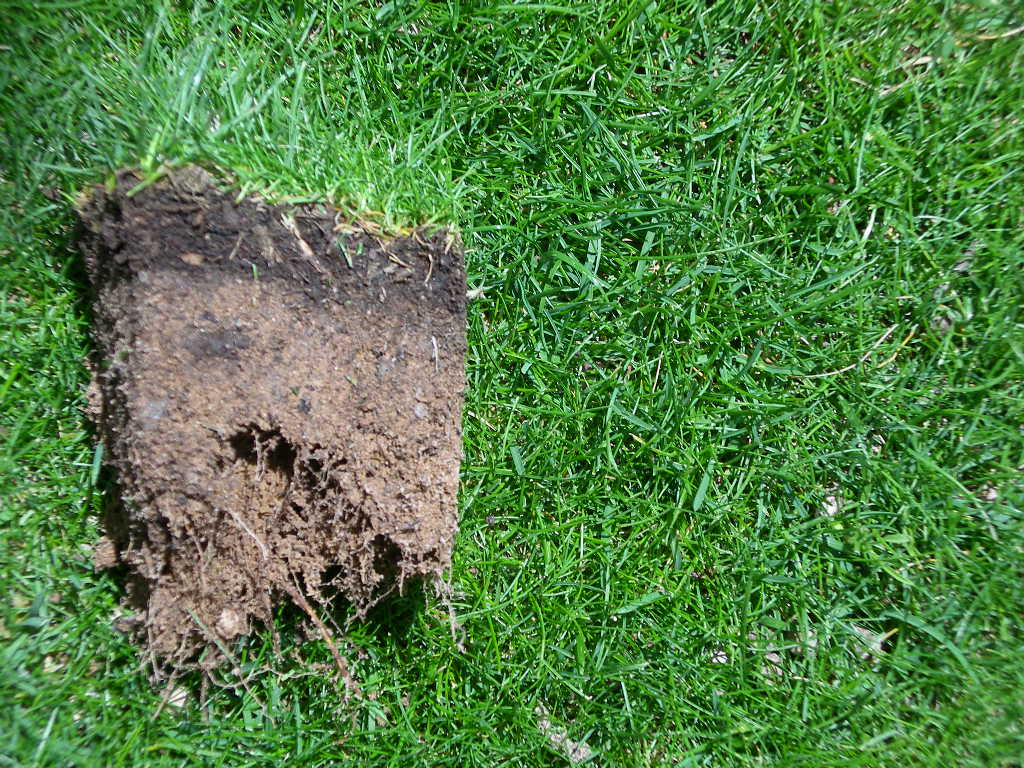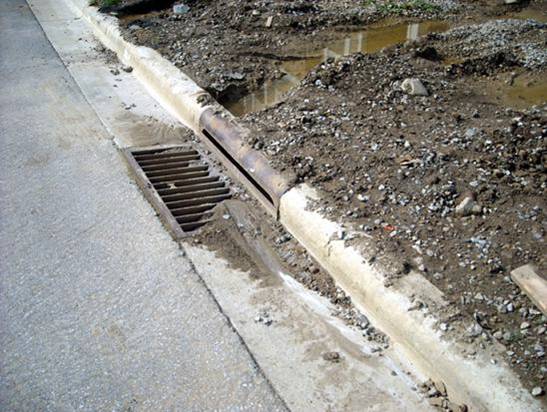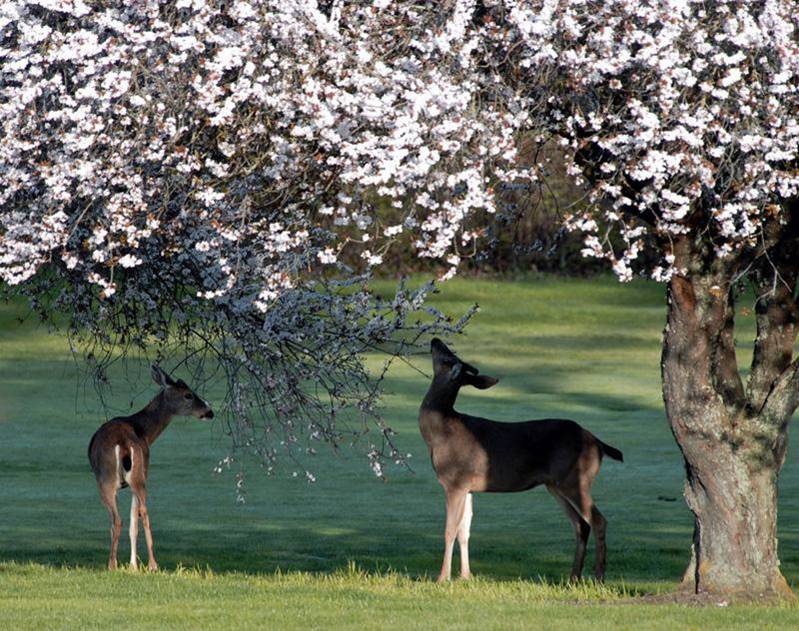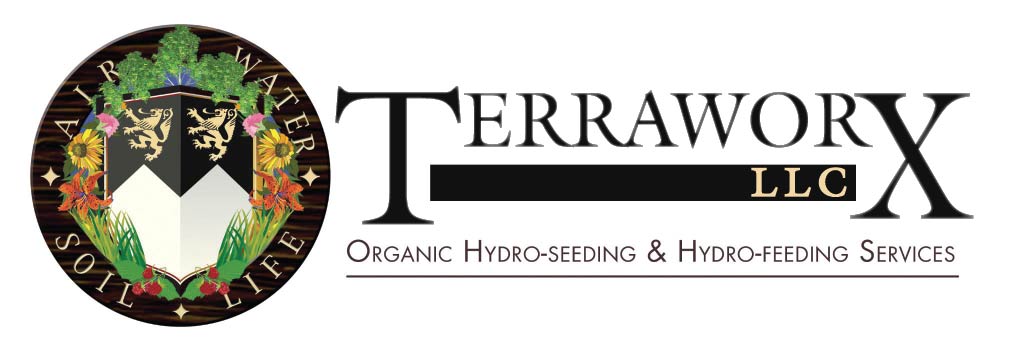|
"Grass is the forgiveness of nature - her constant benediction.
Forests decay, harvests perish, flowers vanish,
but grass is immortal."
~ Brian Ingalls |
 CARBON STORAGE (SEQUESTRATION)
 By PAMELA SHERRATT, Ohio State University:
Grasses, like all plants, capture atmospheric carbon dioxide and use it via photosynthesis to create energy in the form of sugars and carbohydrates. With increasing levels of CO2 and other harmful gasses associated with the greenhouse effect (global warming); turf grasses serve as a source of carbon storage, or sequestration via the beneficial fungi known as Mycorrhizae (root fungus).
The video below demonstrates how these fungi connect and interact, on a simplistic level, with the root system. This animation shows the electrical responses that activate the transfer of nutrient from the Mycorrhizae fungi to the root as well as the transfer of sugars that feed these amazing root fungus.
(Video name: Underground Market. Created & Copyright by The Ascender)
Most of the turf volume, or biomass is below ground. Given the perennial nature of turf, the storage of carbon in root mass and organic matter (Humus) development in the soil, turf and grasses are a significant carbon sink. This is only possible with the symbiotic relationship with the Mycorrhizae fungi. An average-sized healthy lawn, meadow, or pasture is a carbon sequestering system that can capture as much as 300 pounds carbon per year and a golf course fairway can capture 1,500 pounds carbon per year.
Research has also concluded that carbon storage in grasses is comparable to the rate of carbon storage in land situated in the Conservation Reserve Program.
A practical example of carbon sequestration (Humus) is that one soccer field can offset the carbon produced by a car driving 3,000 miles. Although positive carbon sequestration does occur in a grass system, some of the benefit is achieved through reduced maintenance practices (hidden costs) that requires fossil fuel use such as mowing, fertilizers, and "cides". Reducing carbon emissions during grass management is a consideration for both professional managers and homeowners alike. practical example of carbon sequestration (Humus) is that one soccer field can offset the carbon produced by a car driving 3,000 miles. Although positive carbon sequestration does occur in a grass system, some of the benefit is achieved through reduced maintenance practices (hidden costs) that requires fossil fuel use such as mowing, fertilizers, and "cides". Reducing carbon emissions during grass management is a consideration for both professional managers and homeowners alike.
Nevertheless, research over the last few years has concluded that practices like mowing, returning clippings, organically and biologically feeding and watering actually increases the grasses ability to sequester carbon. Basically, the healthier the grasses, the more carbon it can store.
|
 SOIL, WATER, & NUTRIENT STABILIZATION
 By PAMELA SHERRATT, Ohio State University:
 Grasses also play an important role in soil erosion, dust control, and water runoff by holding the soil in place. The fibrous root system of grasses form excellent soil "netting" that reduces dust and stabilizes soil on both flat and sloping areas. Healthy turf has the ability to absorb and conserve water though root depth, filter water and prevent run-off. which is why grasses are often used on slopes, roadsides, and around parking lots. Since grasses are a perennial and stable ground cover that is not cultivated, it slows storm water run-off reducing erosion potential and also improves the likelihood of the water infiltrating down through the soil. Grasses also play an important role in soil erosion, dust control, and water runoff by holding the soil in place. The fibrous root system of grasses form excellent soil "netting" that reduces dust and stabilizes soil on both flat and sloping areas. Healthy turf has the ability to absorb and conserve water though root depth, filter water and prevent run-off. which is why grasses are often used on slopes, roadsides, and around parking lots. Since grasses are a perennial and stable ground cover that is not cultivated, it slows storm water run-off reducing erosion potential and also improves the likelihood of the water infiltrating down through the soil.
Run-off and erosion of soil is considered to be one of the primary causes of nutrient contamination in our water systems (Rio Grande is a perfect example). Reducing storm water run-off from impervious surfaces is a relatively new concept in landscape design, with rain gardens being developed in some residential neighborhoods. Some researchers are also recommending designing grass areas to serve as catchments and filtration zones for polluted run-off water.
Grass systems are not only efficient at catching and filtering water, but are also very efficient at holding on to nutrients. Nutrients like phosphorus are fixed onto soil particles or taken up by the plant and they do not leach out readily.
|
 THE COOLING EFFECT
 By PAMELA SHERRATT, Ohio State University:
As communities grow from a village to a town to a city and increase in temperature occurs. In major cities the term urban heat island is used to characterize the temperature increase. On warm summer days, the temperature can be 10o F greater in an urban area compared to the surrounding area. A 5,000 square foot Bluegrass Lawn contains about 9 million shoots, while an average creeping Bentgrass putting green contains 72 million individual shoots. Each of these plant shoots carries a cooling process called transpiration. Transpiration helps reduce temperatures in the urban environment by dissipating high levels of radiation. To that end, grasses are considerably cooler than other common surfaces. Research at Brigham Young University has recorded temperatures on grasses twenty degrees cooler than bare soils and forty degrees cooler than synthetic turf.
Surface Heat Study
| Surface Type |
Average Surface
Temperature (7am-7pm)
degrees Fahrenheit (F)
|
| Synthetic Turf |
117 |
| Asphalt |
109 |
| Bare Soil |
98 |
| Concrete |
94 |
| Grasses |
78 |
Transpirational cooling is dependent on an adequate supply of water. In grass areas, water is provided by rainfall or by irrigation, depending on length of growing season, temperature, evapotranspiration rates, soil type, grass species and management practices. It is estimated that grasses, including residential and commercial lawns, native grass meadows, golf courses, etc., is the largest single irrigated crop in the United States. While residential landscapes are typically watered with municipal sources, golf courses irrigation comes primarily from on-site ponds and lakes that stores fresh or affluent water, wells and streams.
Regardless of location though, if supplemental irrigation is needed, there are many university bulletins and fact sheets that can be used as a guide. There are standard guidelines on irrigation timing, amount, and frequency, to make sure that water is used appropriately.
Reference: Williams, C.F. and Pulley, G.E. (2002) Synthetic Surface Heat Studies, Brigham Young University
|
 TURF IN THE URBAN LANDSCAPE
 By PAMELA SHERRATT, Ohio State University:
 The last role that grasses plays in society is in value to the landscape and urban environment. Grasses help provide a pleasing urban environment through noise abatement, glare reduction, fire protection, and pest reduction. Grasses, like that of golf courses and parks also protect and foster wildlife. The natural state of these landscapes, coupled with the addition of trees, ponds, lakes, and wetlands support a diverse population of birds, animals, and plants. Studies looking at landscaping & house values have found that there is a positive relationship between a home's value and the existence of trees and grasses, up to a certain threshold. The last role that grasses plays in society is in value to the landscape and urban environment. Grasses help provide a pleasing urban environment through noise abatement, glare reduction, fire protection, and pest reduction. Grasses, like that of golf courses and parks also protect and foster wildlife. The natural state of these landscapes, coupled with the addition of trees, ponds, lakes, and wetlands support a diverse population of birds, animals, and plants. Studies looking at landscaping & house values have found that there is a positive relationship between a home's value and the existence of trees and grasses, up to a certain threshold.
Grasses are plants that are used extensively as a stable and perennial ground cover. Grasses are a positive carbon sink and offers many benefits, not just to the environment but also to urban living and increases the over all quality of life.
|
|
 LIKE US !
 RESIDENTIAL
 COMMERCIAL
|











